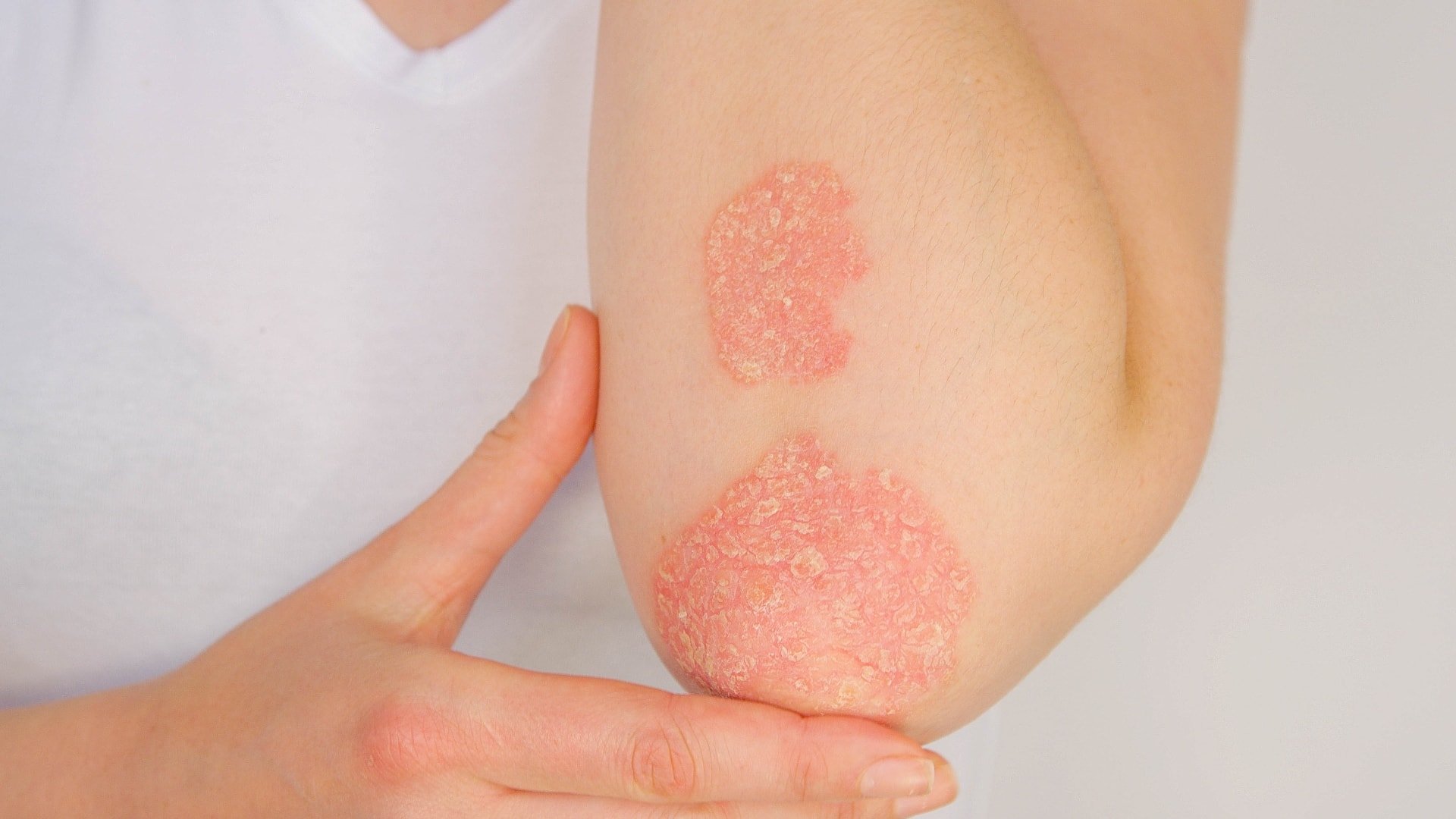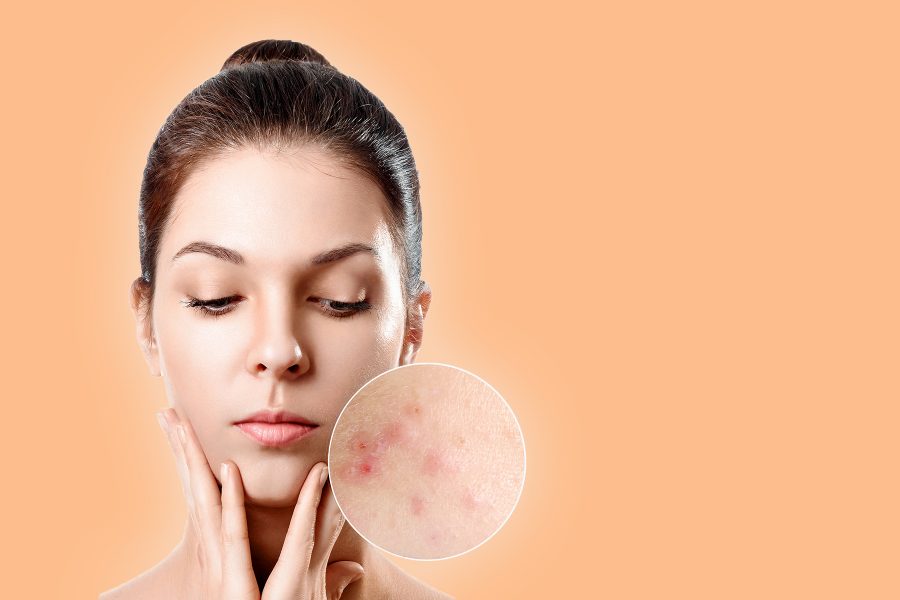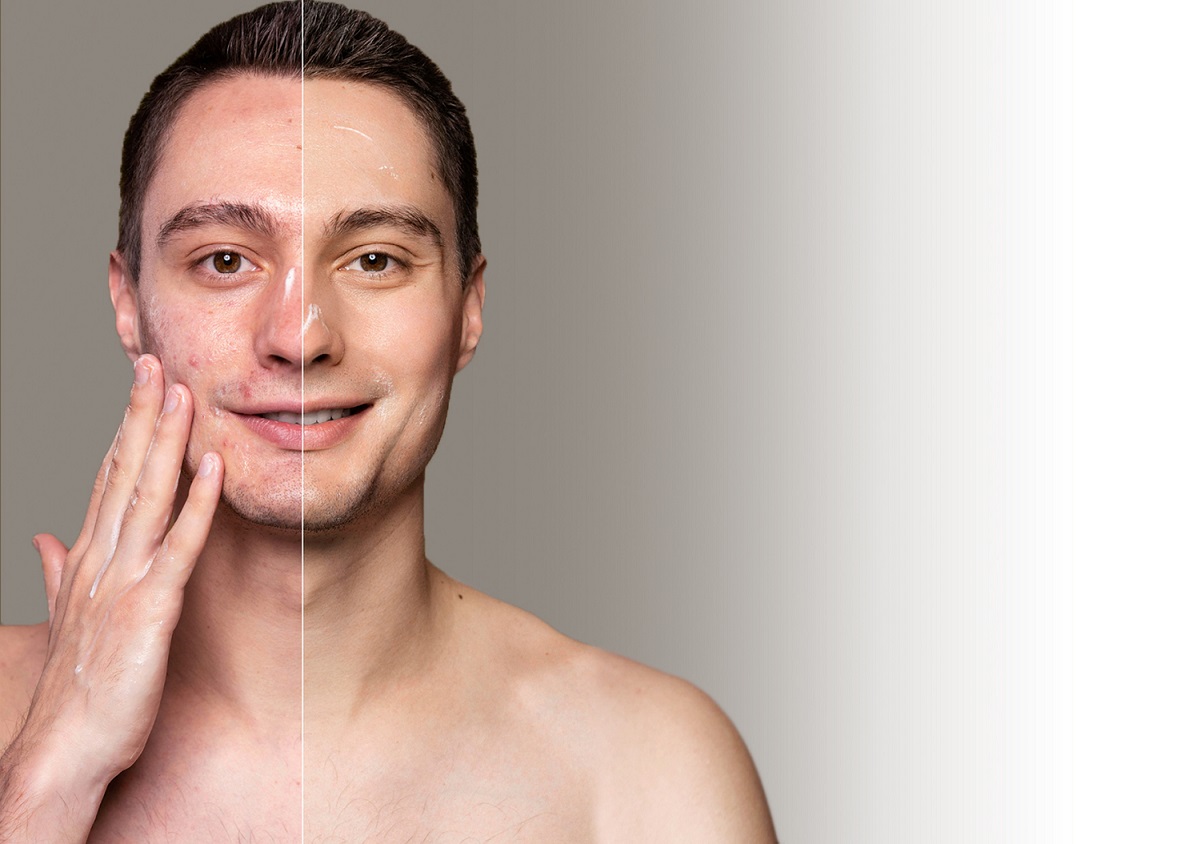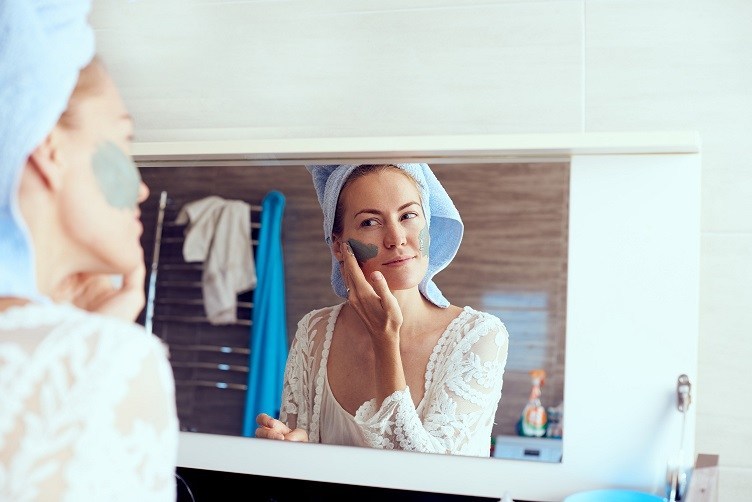
Our very own Dr. Benjamin Barankin, recognized psoriasis expert, was quoted by The Chronicle of Skin & Allergy discussing recent findings in a study related to psoriasis.

Our very own Dr. Benjamin Barankin, recognized psoriasis expert, was quoted by The Chronicle of Skin & Allergy discussing recent findings in a study related to psoriasis.

A while ago we discussed acne and scarring and at home solutions to combat breakouts while in isolation. As we move into the next phase of covid reopening, we can start considering treatments in the clinic to go along with what we are doing at home.
In-clinic procedures for active acne vary from facials (currently restricted) to chemical peels to laser treatments. The appropriate treatment plan can be established through a consult and assessment with your medical esthetician or with your dermatologist. But, let’s discuss a little first.
When acne is to the point that regular medication such as topicals or antibiotics are no longer helpful, I have found the next step is either PDT or isotretinoin or hormonal therapy(in women) . These treatments are effective for acne and each have their own set of positives and negatives. Once acne is clear, then steps towards reducing scarring should be reviewed with your medical esthetician and/or your dermatologist.
Without a doubt, the most intense, but effective treatment is PDT, or PhotoDynamic Therapy. Quite often 2-3 sessions, 1 month apart will shrink the sebaceous glands and kill off bacteria. In most cases, acne is gone, although a pimple here and there may still occur. During the session, the skin is prepped and a medication called Metvix (often covered through your drug plan) is applied, occluded, and left to incubate for 2-3 hours. The medication is activated with Aktilite (or other laser or light-based device such as BBL), a light activated device made specifically for PDT. There is a post-protocol to follow, but acne and even some acne scars will start to reduce even after 1 session. Most patients need 2 sessions, with results being successful over 90% of the time.
Facials, when we are able to start treating again, are perfect for reducing blackhead accumulation, pustules and inflammation. They provide a deep cleanse, hydration and balance the skin. They can be performed alone or as the perfect accompaniment to any of our other treatments, especially chemical peels or silk-peel microdermabrasion.
Chemical peels and silk-peel microdermabrasion are all effective to reduce congestion, brighten up the skin and I find that chemical peels are specifically effective at reducing scarring and acne equally, making it the perfect go-to when our patients are anxious to reduce scars but are still finding their acne to be too active to start a laser scar reduction treatment plan. Silk-peel microdermabrasion requires no downtime, but when performing chemical peels, we suggest not having any important events happening for up to a week or so due to mild or moderate peeling.
When we talked about scars before, I mentioned that there are different types of scars. In most cases, we have certain lasers for specific types of scarring. For example, if the patient has redness left after the pimples are gone, we need to use lasers that will remove the red from the skin. The Laser Genesis with the Excel V KTP laser combination works very well, with anywhere from 3-6 treatments to clear the skin. With post -inflammatory hyperpigmentation, or brown discoloured areas (PIH), the BBL or the Excel V or Gentle Max Pro can be very effective, and the appropriate laser and settings will be chosen for each specific skin type and level of pigment. And for recessed/depressed scars, we find the ProFractional laser ideal for all skin types.
Microneedling and Microneedling with PRP (Platelet-rich plasma) are non-laser treatments for texturized scars that can also have a positive effect on redness and discolouration as well. By stimulating your own collagen, we are able to raise recessed scars and flatten raised scars. Although we can’t promise perfection, the ability to smooth the skin’s surface also reduces the shadows that accompany recessed scars, making the skin brighter and more healthy looking. The ProFractional Laser is the most comprehensive resurfacing laser providing optimal collagen stimulation with each and every session. With the ability to add heat for lighter skin tones, thus adding more collagen stimulation, the ProFractional laser is extremely customizable with less side effects than any other resurfacing laser on the market.
Dermatology treatments for some specific types of scars can be addressed through TCA CROSS (for ice pick scars), subcision with or without fillers (for depressed/recessed “boxcar” scars), and punch/simple excision for stubborn small scars. These options can be discussed with your dermatologist.
In the end, the first step will be to see your medical esthetician or dermatologist for assessment and education into the best personalized options for you. Thankfully in this day and age, we have many great treatment options to offer and our clinic has a special expertise and years of experience treating both acne and acne scars. Call us at 416-633-0001 x2 to book your consultation.
~ Sheri Roselle, Medical Esthetician, Toronto Dermatology Centre

Over 80% of the population experiences some kind of acne in their lifetime, ranging from a mild pimple, a few blackheads occasionally, to all-out war on the face with inflamed, raised and irritated pustules covering a portion or more of the face, short or long-term.
Our dermatologists can prescribe medications (both oral and topical) to alleviate the acne, and our medical estheticians provide services to speed up the healing process and the marks. But, there is likely to be a chance of residual scarring for the more moderate-to-severe cases..
I tend to divide acne scarring into three categories, although some patients may have anywhere from one to all three types on their face.
Dealing with pigmentation is frustrating but also fortunately the easiest type to treat. You may have been on a topical or oral medication for acne but didn’t apply and reapply your sunscreen every day (yes, this also includes the winter for all of you who think the sun only comes out in the summer). Or, you may have chosen to pick and pop those pimples. I know it’s hard to resist!!
There are products that will help to reduce and fade the pigment over time. They work extremely well, but they can take months of daily use for full results, and of course sunscreen does need to be applied daily as well. There are a multitude of medical topical creams that work to reduce pigment book a consultation and we can help you build a skin regimen.
Red or purple scarring is a little tougher to combat without treatment, but some products will reduce the intensity of the colour and help blend into your natural skin tone a little better.
Products containing anti-inflammatories such as B3, niacinamide and licorice root or green tea will help to cool and calm the skin. Salicylic acid (2%) used in moderation in your cleanser or toner can actually also be helpful, but be sure to moisturizer properly afterwards.
Vitamin A/Retin-A/Retinol topically has proven to be effective with every type of acne scarring, reducing pigment changes, repairing cells and reducing redness. However, if you haven’t used medical grade Vitamin A, either Retin A or retinol before, I highly suggested you book a time to come in and speak to one of our medical estheticians to find out if this product is right for you.
Lastly, textured scars are generally treated in the clinic, and we will discuss in detail in Part 2 in my next blog. Again, Retinol products, AHA/BHA and are great for exfoliating (without being overly aggressive) and will not only help with texture but is recommended even if you are doing treatments in the clinic.
So why not get a head start now? Email us your skin concern at cosmeti@torontodermaotlogycentre.com and let us help trailor a treatment plan custom for you only.

There has been some confusion over whether or not interruption of treatment services will affect your overall outcome and reduce results. So, let’s go over different services that you may have been in the midst of having done when the COVID 19 pandemic forced the clinic to temporarily close down and what effect it may have on your eventual outcome.
If you have been doing laser hair removal, the good news is that, although it may take a little longer for the final result, it is only because you weren’t able to get 1-2 treatments in during lockdown. There is absolutely no interference by delaying your treatments. When the energy from the laser is absorbed into the hair follicle, it will either destroy the root right then and there, or it won’t. Delaying the next appointment won’t make new hairs grow and won’t make destroyed roots suddenly appear. So, for laser hair removal, there is nothing to be concerned with and you can start up again once our clinic has the green light to begin services again.
If you have been treating your skin with the BBL/IPL (photorejuvenation) or laser for pigment or brown spots, or doing chemical peels for the same, again, each treatment presents its own results. Additional treatments improve results, but there is no timeline as to when they need to be done. Some people with minimal sun damage may only come in 1-2 times per year and still get fantastic results.
When treating for anti-aging or scar reduction, again each treatment and its results is independent. For example, if you are doing PRP with microneedling or Profractional laser resurfacing treatments, each treatment creates a controlled damage to the cells which in turn, helps to repair damaged skin and stimulate collagen. Sure, the end results take a little longer, but only because it will take longer to get your full number of treatments done.
So, now to the trickier treatments with a little more emphasis on timelines. When we are dealing with vascularity (redness) it can depend on the actual treatment and the severity of the condition. Ideally, when I am treating someone with rosacea, I do like to treat about a month apart. Each treatment will help to coagulate the vessel and will produce results. However, I do find that treating closer together will speed up the end result. Some vessels will disappear within a month after the treatment, but some haven’t coagulated completely, & some not at all. Those that haven’t coagulated at all, well they can be treated anytime. But some vessels will disappear if treated closer together. Does this mean that if you have had 2-3 treatment sessions and then haven’t been able to treat for the past three months that you have wasted your money? Definitely not. Collagen has been produced, vessels have disappeared. Sure, it isn’t perfect, but the results from each treatment will still count towards the final goal.
ly, I will discuss simpler treatments like facials and silk peel microdermabrasion. These treatments are great for the skin and could be done as often as once a month if the patient feels inclined to do so. Like making a bed every day or eating breakfast, ongoing treatments are ideal for almost every skin type. But can we tolerate going without?? Well, like me missing my weekly HIIT classes, I have found alternatives. I work out at home and do my best in the meantime. I can’t wait to get back and do it properly, but for now I am keeping up appearances. That applies to these treatments too. I have previously posted options for do it yourself facials and exfoliation at home. Providing you are using good home care and not overdoing it, you will be fine until we are back up and providing full services again.
So, there you have it. In most cases, a break in the routine won’t have any long-term effect on the final results. We may have ideal timelines that we prefer (largely to get treatments and results completed faster), but each treatment performed on you gives results that won’t be reversed because you haven’t been able to get in.
Please feel free to call us or email us with any questions. We are slowly in the process of reopening the clinic now, and although not able to perform all services yet, we are here & more than happy to answer your questions and concerns.
~ Sheri Roselle, Medical Esthetician at Toronto Dermatology Centre

Have you seen some of the images of nurses and doctors after a full, and very long day after taking off their masks and protective eyewear? The skin has been chafed off, leaving red, crusty skin along the contact areas. It looks painful and irritated. It makes us appreciate all that they have been doing for us in a visually compelling way that we might not have thought of before.
I know that when I return to work, as will be the case for most people too, that protective masks and possibly eye protection will be the norm, at least until a vaccine has been established here in Canada for the coronavirus. I want to be able to protect my skin and I want others to know what they can do too, so that we can prevent or repair damage from our protective wear.
It is most important at this time, and in the foreseeable future to keep the skin extremely hydrated. Beyond drinking plenty of water, which is very important as well, there are some steps we can take to help prevent skin damage. To start, unless you are suffering from acne, I suggest washing at night-time only, as washing frequently will reduce the natural hydration of the skin. In the morning, apply a hydrating serum, such as SkinMedica Hydrating Serum or Skinceuticals H.A. Infusion followed by a light barrier cream. I suggest the Epidermal Repair for most skin types or the Dermal Repair for very dry skin. And even though we are wearing protection, getting to work still requires a good sunscreen for added protection. For those concerned with pigment or aging, I suggest the CE Ferulic serum or SkinEssentials MD Texture Perfector as well in the morning, applied first, before all the other products.
During the daytime, we shouldn’t be touching our faces, but if the irritation is intense, there is a beautiful healing product, Zo Hydrating Cream that is absolutely the best. I suggest washing your hands first, removing the protective wear, wash hands again and apply a small dab of the Hydrating cream. It will instantly make the skin feel cooler, calmer and healthier. Don’t forget to wash hands again before applying your protective wear for the rest of the day.
At night time, be sure to wash with a less aggressive cleanser and be sure to remove all of the cleanser with a baby washcloth and warm water. There are two ways I will be doing my night routine, most likely alternating nights. The first night after washing my face, I will apply my serum again, either the HA Infusion again or the TNS Essential Serum, which not only helps collagen production but is full of vitamins to help my skin heal. I will finish off with one of the moisturizers listed earlier or the Triple Lipid Restore.
On alternate evenings I will wash and apply a serum again, but instead of applying a moisturizer, I will apply the Phyto Corrector Mask in a thin layer (it is a light green gel, almost transparent) and leave it on overnight. In the morning, instead of removing the residue with water, I will use a light toner, such as the Gentle toner from Zo before my day routine begins.
For those with oily skin, wearing a mask is not going to be the most fun thing in the world either, but keeping up with a good acne routine and adding the Epidermal Repair mornings and evenings will allow you to treat the acne while keeping the skin protected from the friction of the masks and goggles. And again, no matter the skin type, if you’re going to be outside or at a car window, a good sunscreen is still advised for healthy skin.
During this time and moving forward, a high percentage of the population will be choosing to protect themselves and their patients/clients by social distancing and wearing protective gear, at least for the foreseeable future. But, we don’t have to let the quality of our skin slide.
There is a light at the end of this scary tunnel, and we want everyone to look and feel their best for when they come out the other side.
~ Sheri Roselle, Medical Esthetician at Toronto Dermatology Centre
The CDA recognizes World Melanoma Day, Monday, May 11th as an important opportunity to draw attention to the rising incidence rate of this skin cancer among Canadians—one of the few types of cancer that continues to increase every year.
The CDA will also release the results of the latest Sun Safe Behaviour Survey, which reveals what Canadians know about preventing skin cancer and what they are actually doing to prevent it. Although some findings are encouraging, the survey also identified some worrisome trends.
Canadians increasingly understand the risks of sun exposure and the harmful effects of ultraviolet UV radiation. They are also changing some behaviours to better protect themselves. However, Canadians continue to have misconceptions about some aspects of sun safety. Check out our infographic below:
CDA Sun Safe Behaviour Data Key Findings will be released to the media on this Monday, May 11th. To help prepare for media interviews, the full survey report and core sun protection messaging resources are available on the CDA member portal in the “Media Prep” section.
Credit: Canadian Dermatology Association
April is Rosacea Awareness Month (designated by the National Rosacea Society) and our doctors have been posting information on social media sites this month to help patients understand what rosacea is and how to deal with it. Along with what they can do for you, we, as medical estheticians provide the key to removing the visual effects rosacea has left behind.
Rosacea Awareness Month may only be 30 days long, but if you have rosacea, then you know it is a life-long struggle in coping with the effects that rosacea has on your skin. Mild symptoms such as easy flushing and a few broken capillaries are annoying but tolerable, whereas intense symptoms such as skin sensitivity, stinging and burning, or broken vessels across the face, or pimples and pustules, are often more intolerable and can play havoc not only on the skin, but on your mental and emotional health as well.
While mild cases can be treated with a topical prescription medication (several good options from your dermatologist), a quality moisturizer and proper sun protection, the more intense cases may need all of the above and a whole lot more. Active moisturizers such as ZO Rosatrol actually help to calm the skin as well as hydrate. SkinMedica carries an amazing sunscreen that helps to lower the temperature of the skin to prevent flushing, as does the Phyto mask from Skinceuticals. A cream or milk cleanser is ideal to prevent water loss and exfoliators have to be very specific in order for a rosacea skin to tolerate them well.
But here’s the thing: medications, moisturizers and sunscreen will help to calm the skin and reduce flare-ups, but they won’t remove the redness if the capillaries are already broken. That is where we come in. Once the vessels are visible on the skin, the only way to remove them is through laser or light therapy. We are talking about lasers or BBL (IPL) photorejuvenation and sometimes a combo of them.
After a proper assessment with your medical esthetician, and under the supervision of your dermatologist, we choose the best means to treat the visible vessels and reduce flushing. For most patients it can take approximately 6 treatments about a month apart to get the best results, along with proper home skincare, of course. Because rosacea is something that you have for life, we also suggest 1-2 treatments every year to prevent accumulation of new vascularity. On the plus side, it has been clinically proven that both BBL and lasers stimulate collagen production. So, while treating the redness and vessels of rosacea, there is the added benefit of anti-aging effects as well. In fact, many patients who don’t even have rosacea will do exactly the same treatments just for the collagen stimulation benefits alone.
And keep in kind that those who suffer from rosacea are lacking a proper moisture barrier, which prevents the skin from holding onto water. With new collagen being created, not only are we reducing the current vessels, but we are preventing a surge in new broken vessels because the skin will be more hydrated and therefore less sensitive and reactive.
If you have, or feel you may have rosacea, the first step is to come and see one of our dermatologists for assessment. It is important to determine what type of rosacea you have as well as its severity. It is important to know that topical or oral medications will calm and help to prevent new flare-ups, but understand that to clear up the damage that has already taken place, your medical esthetician is the key to recovery.
While we are not in the clinic at this time (but very soon), you can still be assessed by our derms, as they are seeing patients virtually (just email us at econsult@torontodermatologycentre.com). After that, please feel free to contact the clinic and we can determine the proper care for you. Send pics and any information you feel is relevant. One of our medical estheticians will guide you along until we are back in the clinic. When we are able to meet in person, we can guide you along to the best laser or BBL option to address your rosacea.
We will be back in the clinic seeing and helping our patients soon. Meanwhile, stay safe, enjoy this time with your family, and try to stay stress free!
~ Sheri Roselle, Medical Esthetician at Toronto Dermatology Centre